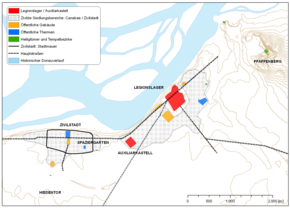Carnuntum

The legionary fortress, auxiliary fort and town (canabae)
|
|
| Location | Lower Austria, Austria |
|---|---|
| Region | Pannonia Superior |
| Coordinates | 48°07′N 16°52′E / 48.117°N 16.867°ECoordinates: 48°07′N 16°52′E / 48.117°N 16.867°E |
| Type | Castrum |
| History | |
| Periods | Roman Empire |
Carnuntum (Καρνους, Carnous in Ancient Greek according to Ptolemy) was a Roman Legionary Fortress or castrum legionarium and also headquarters of the Pannonian fleet from 50 AD. After the 1st century it was capital of the Pannonia Superior province. It also became a large city of 50,000 inhabitants.
Its impressive remains are situated on the Danube in Lower Austria halfway between Vienna and Bratislava in the "Carnuntum Archaeological Park" extending over an area of 10 km² near today's villages of Petronell-Carnuntum and Bad Deutsch-Altenburg.
Carnuntum first occurs in history during the reign of Augustus (6 AD), when Tiberius made it his base of operations as a Roman fort in the campaigns against Maroboduus (Marbod).
Significant Romanisation occurred when the town was selected as the garrison of the Legio XV Apollinaris before 14 AD. A few years later, it became the centre of the Roman fortifications along the Danube from Vindobona (now Vienna) to Brigetio (Ó-Szőny). According to Tacitus, the emperor Claudius ordered the governor of Pannonia "to have a legion with an auxiliary on the bank of the Danube" to protect the losers of a dispute between Germanic tribes (the Quadi and Marcomanni) and deter the victors from the temptation to invade Pannonia. To this period (about 50 AD) belongs the auxiliary castrum of a cavalry ala 1.5 km south-west of the legionary fortress.
...
Wikipedia

